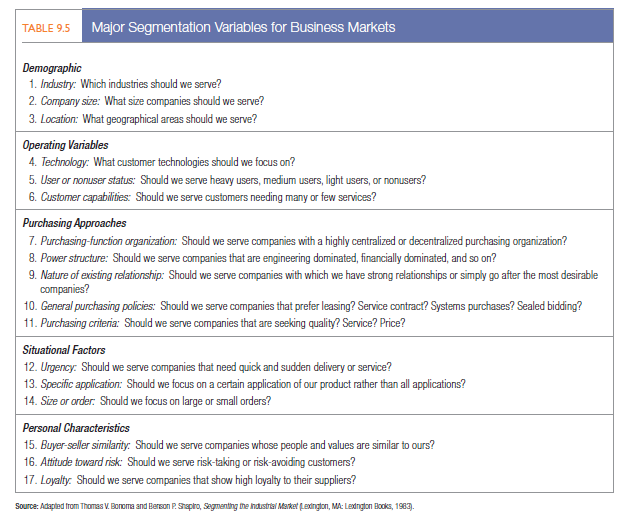We can segment business markets with some of the same variables we use in consumer markets, such as geography, benefits sought, and usage rate, but business marketers also use other variables. Table 9.5 shows one set of these. The demographic variables are the most important, followed by the operating variables—down to the personal characteristics of the buyer.
The table lists major questions that business marketers should ask in determining which segments and customers to serve. A rubber-tire company can sell tires to manufacturers of automobiles, trucks, farm tractors, forklift trucks, or aircraft. Within a chosen target industry, it can further segment by company size and set up separate operations for selling to large and small customers.
A company can segment further by purchase criteria. Government laboratories need low prices and service contracts for scientific equipment, university laboratories need equipment that requires little service, and industrial labs need equipment that is highly reliable and accurate.
Business marketers generally identify segments through a sequential process. Consider an aluminum company: The company first undertook macrosegmentation. It looked at which end-use market to serve: automobile, residential, or beverage containers. It chose the residential market, and it needed to determine the most attractive product application: semifinished material, building components, or aluminum mobile homes. Deciding to focus on building components, it considered the best customer size and chose large. The second stage consisted of microsegmentation. The company distinguished among customers buying on price, service, and quality. Because it had a high-service profile, the firm decided to concentrate on the service-motivated segment of the market.

Business-to-business marketing experts James C. Anderson and James A. Narus have urged marketers to present flexible market offerings to all members of a segment.64 A flexible market offering consists of two parts: a naked solution containing the product and service elements that all segment members value and discretionary options that some segment members value. Each option might carry an additional charge. Siemens Electrical Apparatus Division sells metal-clad boxes to small manufacturers at prices that include free delivery and a warranty, but it also offers installation, tests, and communication peripherals as extra-cost options.
Source: Kotler Philip T., Keller Kevin Lane (2015), Marketing Management, Pearson; 15th Edition.

Very nice article and right to the point. I am not sure if this is really the best place to ask but do you folks have any thoughts on where to get some professional writers? Thanks in advance 🙂